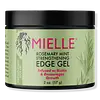What's inside
What's inside
 Key Ingredients
Key Ingredients

 Benefits
Benefits

 Concerns
Concerns

 Ingredients Side-by-side
Ingredients Side-by-side

Water
Skin ConditioningCeteareth-25
CleansingGlycerin
HumectantPEG-7 Glyceryl Cocoate
EmulsifyingPEG-40 Hydrogenated Castor Oil
EmulsifyingPropylene Glycol
HumectantEthylhexylglycerin
Skin ConditioningOlea Europaea Fruit Oil
MaskingMentha Piperita Oil
MaskingRosmarinus Officinalis Leaf Oil
MaskingEquisetum Arvense Extract
AstringentOrbignya Oleifera Seed Oil
EmollientZingiber Officinale Root Oil
MaskingCocos Nucifera Oil
MaskingHoney
HumectantBiotin
AntiseborrhoeicLawsonia Inermis Extract
AntimicrobialRosmarinus Officinalis Extract
AntimicrobialHumulus Lupulus Extract
AntimicrobialUrtica Dioica Extract
AstringentPhenoxyethanol
PreservativeAnthemis Nobilis Flower Extract
MaskingSymphytum Officinale Callus Culture Extract
Skin ConditioningBenzoic Acid
MaskingGlycereth-2 Cocoate
EmulsifyingParfum
MaskingWater, Ceteareth-25, Glycerin, PEG-7 Glyceryl Cocoate, PEG-40 Hydrogenated Castor Oil, Propylene Glycol, Ethylhexylglycerin, Olea Europaea Fruit Oil, Mentha Piperita Oil, Rosmarinus Officinalis Leaf Oil, Equisetum Arvense Extract, Orbignya Oleifera Seed Oil, Zingiber Officinale Root Oil, Cocos Nucifera Oil, Honey, Biotin, Lawsonia Inermis Extract, Rosmarinus Officinalis Extract, Humulus Lupulus Extract, Urtica Dioica Extract, Phenoxyethanol, Anthemis Nobilis Flower Extract, Symphytum Officinale Callus Culture Extract, Benzoic Acid, Glycereth-2 Cocoate, Parfum
Water
Skin ConditioningCetearyl Alcohol
EmollientBehentrimonium Chloride
PreservativeGlycerin
HumectantAmodimethicone
Cyclopentasiloxane
EmollientCitric Acid
BufferingIsopropyl Alcohol
SolventCetrimonium Chloride
AntimicrobialSodium Benzoate
MaskingDimethicone
EmollientTrideceth-12
EmulsifyingPanthenol
Skin ConditioningParfum
MaskingTocopheryl Acetate
AntioxidantCaramel
Cosmetic ColorantButylene Glycol
HumectantCornus Officinalis Fruit Extract
Skin ConditioningRehmannia Glutinosa Root Extract
Skin ConditioningDioscorea Japonica Root Extract
Skin ConditioningAlisma Orientale Tuber Extract
Skin ConditioningPaeonia Suffruticosa Root Extract
Skin ProtectingPoria Cocos Sclerotium Extract
AstringentCeramide NP
Skin ConditioningAlcohol
AntimicrobialHydrolyzed Silk
HumectantHydrolyzed Collagen
EmollientGelatin
Hydrolyzed Keratin
HumectantAvena Sativa Kernel Extract
Abrasive1,2-Hexanediol
Skin ConditioningHydrolyzed Wheat Protein
Skin ConditioningHydrolyzed Corn Protein
Skin ConditioningHydrolyzed Soy Protein
HumectantPhenoxyethanol
PreservativeDaucus Carota Sativa Root Extract
Skin ConditioningBrassica Oleracea Italica Extract
AstringentApium Graveolens Extract
Skin ConditioningSodium Dehydroacetate
PreservativeBrassica Oleracea Capitata Juice
Skin ConditioningOryza Sativa Extract
AbsorbentBrassica Rapa Leaf Extract
Skin ConditioningEthylhexylglycerin
Skin ConditioningSolanum Lycopersicum Fruit
EmollientIllicium Verum Fruit Extract
PerfumingCaprylyl Glycol
EmollientWater, Cetearyl Alcohol, Behentrimonium Chloride, Glycerin, Amodimethicone, Cyclopentasiloxane, Citric Acid, Isopropyl Alcohol, Cetrimonium Chloride, Sodium Benzoate, Dimethicone, Trideceth-12, Panthenol, Parfum, Tocopheryl Acetate, Caramel, Butylene Glycol, Cornus Officinalis Fruit Extract, Rehmannia Glutinosa Root Extract, Dioscorea Japonica Root Extract, Alisma Orientale Tuber Extract, Paeonia Suffruticosa Root Extract, Poria Cocos Sclerotium Extract, Ceramide NP, Alcohol, Hydrolyzed Silk, Hydrolyzed Collagen, Gelatin, Hydrolyzed Keratin, Avena Sativa Kernel Extract, 1,2-Hexanediol, Hydrolyzed Wheat Protein, Hydrolyzed Corn Protein, Hydrolyzed Soy Protein, Phenoxyethanol, Daucus Carota Sativa Root Extract, Brassica Oleracea Italica Extract, Apium Graveolens Extract, Sodium Dehydroacetate, Brassica Oleracea Capitata Juice, Oryza Sativa Extract, Brassica Rapa Leaf Extract, Ethylhexylglycerin, Solanum Lycopersicum Fruit, Illicium Verum Fruit Extract, Caprylyl Glycol
 Reviews
Reviews

Ingredients Explained
These ingredients are found in both products.
Ingredients higher up in an ingredient list are typically present in a larger amount.
Ethylhexylglycerin (we can't pronounce this either) is commonly used as a preservative and skin softener. It is derived from glyceryl.
You might see Ethylhexylglycerin often paired with other preservatives such as phenoxyethanol. Ethylhexylglycerin has been found to increase the effectiveness of these other preservatives.
Glycerin is already naturally found in your skin. It helps moisturize and protect your skin.
A study from 2016 found glycerin to be more effective as a humectant than AHAs and hyaluronic acid.
As a humectant, it helps the skin stay hydrated by pulling moisture to your skin. The low molecular weight of glycerin allows it to pull moisture into the deeper layers of your skin.
Hydrated skin improves your skin barrier; Your skin barrier helps protect against irritants and bacteria.
Glycerin has also been found to have antimicrobial and antiviral properties. Due to these properties, glycerin is often used in wound and burn treatments.
In cosmetics, glycerin is usually derived from plants such as soybean or palm. However, it can also be sourced from animals, such as tallow or animal fat.
This ingredient is organic, colorless, odorless, and non-toxic.
Glycerin is the name for this ingredient in American English. British English uses Glycerol/Glycerine.
Learn more about GlycerinParfum is a catch-all term for an ingredient or more that is used to give a scent to products.
Also called "fragrance", this ingredient can be a blend of hundreds of chemicals or plant oils. This means every product with "fragrance" or "parfum" in the ingredients list is a different mixture.
For instance, Habanolide is a proprietary trade name for a specific aroma chemical. When used as a fragrance ingredient in cosmetics, most aroma chemicals fall under the broad labeling category of “FRAGRANCE” or “PARFUM” according to EU and US regulations.
The term 'parfum' or 'fragrance' is not regulated in many countries. In many cases, it is up to the brand to define this term.
For instance, many brands choose to label themselves as "fragrance-free" because they are not using synthetic fragrances. However, their products may still contain ingredients such as essential oils that are considered a fragrance by INCI standards.
One example is Calendula flower extract. Calendula is an essential oil that still imparts a scent or 'fragrance'.
Depending on the blend, the ingredients in the mixture can cause allergies and sensitivities on the skin. Some ingredients that are known EU allergens include linalool and citronellol.
Parfum can also be used to mask or cover an unpleasant scent.
The bottom line is: not all fragrances/parfum/ingredients are created equally. If you are worried about fragrances, we recommend taking a closer look at an ingredient. And of course, we always recommend speaking with a professional.
Learn more about ParfumPhenoxyethanol is a preservative that has germicide, antimicrobial, and aromatic properties. Studies show that phenoxyethanol can prevent microbial growth. By itself, it has a scent that is similar to that of a rose.
It's often used in formulations along with Caprylyl Glycol to preserve the shelf life of products.
Water. It's the most common cosmetic ingredient of all. You'll usually see it at the top of ingredient lists, meaning that it makes up the largest part of the product.
So why is it so popular? Water most often acts as a solvent - this means that it helps dissolve other ingredients into the formulation.
You'll also recognize water as that liquid we all need to stay alive. If you see this, drink a glass of water. Stay hydrated!
Learn more about Water